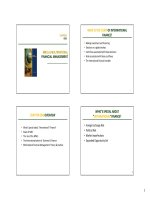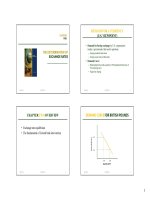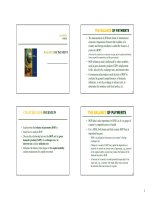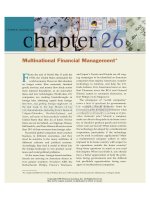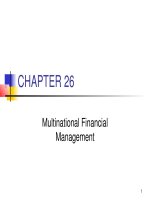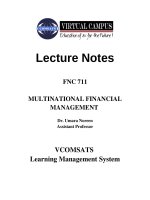Lecture Multinational financial management: Lecture 30 - Dr. Umara Noreen
Bạn đang xem bản rút gọn của tài liệu. Xem và tải ngay bản đầy đủ của tài liệu tại đây (696.02 KB, 46 trang )
Derivatives Usage in Risk Management
by Non-Financial Firms:
Evidence
from Greece
By
Spyridon K. Kapitsinas PhD Center of
Financial Studies, Department of
Economics, University of Athens,
Greece
Impact of International Financial
Reporting Standards
• The introduction of IFRS and the changes
in the accounting
methods that the
Standards dictate have increased the
concern of firms about derivatives usage.
• 71.43% of users indicate that IFRS will have
no effect on derivative use and risk
management strategy.
Methods used for the evaluation of
derivatives’ risk.
• The responses reveal that Value at Risk
is the most popular method of risk
assessment among users since 47.61%
of
them
adopt
it,
with
stress
testing/scenario analysis a close second
at 42.86%.
• Both of these processes are “state of the
art” in the calculation of risk .
Foreign Exchange Risk
Management
• 71.44% of currency derivatives users
indicate that they have foreign currency
revenues that are less than or equal to
10% of their total operating revenues.
• just 14.28% of currency derivatives users
report that 20% of their total revenues
are in foreign currency.
Preference among Foreign
Exchange Derivative Instruments
• In accordance with the international
practice, Greek firms prefer at 85.72% the
forward contracts.
• That is the most important instrument in
handling foreign exchange risk.
• With swaps chosen as first choice by the
14.28% of currency derivatives users.
Percentage of currency derivatives
of various maturities
• The evidence shows that derivative
contracts of shorter maturity are more
commonly used than those extending to
one or more years.
• In particular, 71.43% of currency
derivatives users select contracts with
maturity of ninety days or less.
• The tendency of firms worldwide to
prefer derivatives with short maturity.
Impact of incorporation of market
expectations into CRM
• At 21.43% firms frequently alter the timing
and the size of their hedge based on
their managers’ expectations, rate that is
considerable high but is in accordance
with corresponding surveys.
Preference among interest rate
derivatives
• This part of the questionnaire records the
behavior of firms that hedge the interest
rate risk they face.
• The first question is related to the
derivative contracts that firms chose in
order to hedge the risk from interest rate
variations.
• These contracts are forwards, futures,
swaps, over the counter (OTC) and
exchange
traded
options
and
Frequency of interest rate
derivatives usage for certain
objectives
• According to the evidence, almost all
interest rate derivatives users indicate
that they use derivatives to swap from
floating rate debt to fixed, sometimes at
80% and often at 13.33%.
Impact of market view on interest
rate hedge
• Among interest rate derivatives users
93.33% of firms deny that their market
view support them to actively take
positions in derivatives.
• In contrast, they argue that their market
view may alter the timing of the hedge
either occasionally at 73.33% or often at
20%.
• In conclusion, native firms appear not to
convert their expectations.
Preference among commodity
derivative contracts
• Commodity risk were expected to fill in
this section, which amount 23.80% of all
derivative users.
• The most popular derivative contracts
used for hedging commodity risk are
futures, as revealed by the 60% of
commodity derivatives users.
• Results show that Greek non-financial
firms follow the “U.S. pattern” in hedging
commodity risk.
Options usage across risk
classes
• Firms were asked to indicate which type of
option they have used during the last
twelve months and for hedging which risk
class.
• The proportion of native derivatives users
during last year is 28.57%, that is very low
compared to 69% survey, which was
conducted in UK [El-Masry, 2006].
• 19.07% of firms in the sample used
options to hedge their foreign exchange risk
Frequency of report to board of
directors
• Derivatives users are expected to indicate
the frequency with which they report their
derivative activity to
the board of
directors.
• Firms’ major tendency at 38.09% is to
report on derivatives quarterly, whereas
19.05% of derivatives users report more
often than that, per month.
• Germany, 80% of derivatives users report
to the board of directors monthly.

